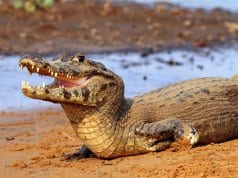Originally founded in 1949, Plitvice Lakes National Park is one of the oldest parks in all of Croatia. The park is quite a popular tourist destination, as more than 1 million visitors travel to the park each year. Given the natural beauty found within the parks 73,000 acres, this shouldn’t be surprising. In fact, visitors not only have the chance to view beautiful vistas and waterfalls in the park, but they also have the chance to walk on lakeside trails, which provide glorious, picturesque views.
But Plitvice Lakes National Park isn’t just a place to see wonderful landscapes – it is also a great location to view wildlife. We’ll point out some of the park’s notable species below, and we’ll even provide wildlife-viewing tips to help you make the most of your visit.
Large Predators of Plitvice Lakes National Park
Plitvice Lakes National Park visitors may have the chance to see several fascinating predators.
Large predators are always some of the most exciting animals to observe in any habitat. Fortunately for Plitvice Lakes visitors, several call the park home.

The largest and most spectacular predator that lives in the park is undoubtedly the Eurasian brown bear. These large predators reach up to 650 pounds in weight, making them large enough to subsist on virtually any prey they wish. Sheep are one of their preferred prey sources, but when they aren’t available, the bears will consume deer, pigs or smaller animals.
Wolves also call Plitvice Lakes National Park home. Although they aren’t as large as the park’s brown bears, they typically hunt in packs. This allows them to take down larger prey than they otherwise would. Lynx also dwell within Plitvice Lakes National Park. Weighing about 40 to 60 pounds, these cats primarily hunt rabbits and similar prey, but they do occasionally take down deer and other large animals.
A Diverse Array of Birds
Plitvice Lakes National Park has the third-largest number of bird species among Croatian parks.
In many ways, the bird life of Plitvice Lakes National Parks mirrors that of other European parks. Woodland species, including crested tits, willow warblers and song thrushes, tend to dominate the area. Additionally, eight different woodpecker species also live within the park’s boundaries and feed on insects found beneath the bark of trees.

Meanwhile, forest-edge species, such as the black grouse become more numerous in places where the canopy opens. Even farther away from the forests, common kestrels and sparrow hawks hunt for bugs, small rodents and other prey.
A few large birds of prey also live within Plitvice Lakes National Park. This includes the Eurasian eagle-owl – one of the largest owls in the world – as well as the equally large and impressive golden eagle.
Reptiles of the Park
A number of interesting and beautiful reptiles live within Plitvice Lakes National Park.
Because Plitvice Lakes National Park is located at a relatively high latitude, it does not have as many reptile species as other parks, located closer to the equator, do. Nevertheless, at least six different species call the park home.

The viviparous lizard (which is named for its ability to produce live young, rather than eggs) is one of the park’s most commonly seen species, as is its close cousin the European green lizard. One turtle – the European pond turtle – also calls the park home and can often be seen basking on rocks and logs near the water.
At least three snake species also live within Plitvice Lakes National Park. The dice snake is likely the most commonly seen species. Completely harmless to humans, the dice snake typically preys on frogs and lizards, but just about any small creature is fair game for these snakes. Two venomous species – the European adder and the horned viper — also live within the park.
Wildlife-Viewing Tips
Make the most of your Plitvice Lakes National Park visit by employing the flowing tips.
Plitvice Lakes National Park provides nature lovers with plenty of chances to see the local wildlife, but the park’s native animals don’t always make it easy to spot them. Accordingly, you’ll want to employ the tips and tricks discussed below to help give yourself the best possible chance of seeing a variety of different species.
- Make sure you visit several of the park’s lakes. Each of the lakes in Plitvice Lakes National Park differs in subtle ways, which means that each will harbor a slightly different slate of species. So, by looking for animals at several of the lakes, you’ll likely see an assortment of different critters.
- Binoculars are a must. If you want to enjoy the bird life at Plitvice Lakes National Park, you’ll definitely want to bring a good pair of binoculars. In fact, they will not only help you see more birds, they’ll also help you observe things like turtles basking on rocks and logs near the water.
- Travel in small groups. You don’t want to hike the trails of Plitvice Lakes National Park alone, as there are potentially dangerous predators afoot. However, you don’t want to travel in very large groups either, as this may scare off some of the most incredible animals that call the park home. Typically, you’ll want to aim for groups of two to four individuals. This will help keep you safe, yet still maintain a low profile, which will allow you to see more animals.

Share Your Experiences!
Although European parks are sometimes overshadowed by those located in Africa, South America or other tropical locations, Plitvice Lakes National Park remains one of the best places in the world for wildlife lovers to visit. Most visitors should see a number of different species, and you’ll be able to enjoy the park’s glorious views while seeking out critters.
Have you ever been to Plitvice Lakes National Park? We’d love to hear about your experiences. Tell us about your trip, and be sure to share the species you saw during your visit.




![Red Angus Closeup of a beautiful Red Angus cowPhoto by: U.S. Department of Agriculture [pubic domain]https://creativecommons.org/licenses/by/2.0/](https://animals.net/wp-content/uploads/2020/03/Red-Angus-4-100x75.jpg)

